From Farm to Screen:
Godzilla
If Mickey Mouse can be characterized as the culture industry’s appeal to the masses’ propensity for carefree escapism, many of its other fantastic creatures captured the popular imagination by playing on the darker aspects of human fears and repressed desires. Godzilla, a primitive, destructive force awakened by the excesses of modern science, was spawned in Ichiro Honda’s 1954 hit film Gojira, and grew rapidly into a pop culture phenomenon even larger than the monster’s massive form. To date, Godzilla has starred in 28 feature films produced by the Toho Film Company, as well as two American remakes, and has also appeared in television series, novels, comic books, video games, songs, toys and countless commercials and advertisements, cementing his position as a mass media “mon-star” of the first order.
Although often enjoyed in the United States for the campiness of its low budget effects, unrestrained fantasy, and comically poor English dubbing, the Godzilla series actually originated in a film with serious political underpinnings. Invented less than a decade after the atomic bombing of Hiroshima and Nagasaki, Godzilla is explicitly described as the result of the indiscriminate use of nuclear weaponry. His unstoppable destructive power, directed against the symbols of modern civilization, makes him the perfect metaphor for the new forces which threaten to destroy it. Ironically, in a moment of remarkable nationalistic fantasy, Godzilla is defeated at the end of the first film by the heroic self-sacrifice of a Japanese scientist who has invented a weapon “even stronger than the atomic bomb,” but who chooses to perish with its secret rather than have it used against humanity.
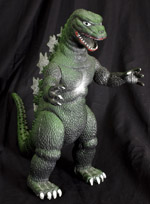 |
Godzilla Model with Moveable Arms and Legs. Japan: Toho Ltd. and Imperial Toys, 1985. [zoom] |
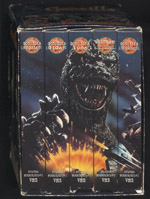 |
A Pictorial Box Set of Five Godzilla Films in Translation. Japan: Toho Ltd. and Anchor Entertainment, 1997. [zoom] | Additional images: 
|
 |
The Godzilla Museum. Tokyo: Asupekuto, 1994. [zoom] | Additional images:  
Godzilla’s status as a pop culture icon was established by its ubiquity across the spectrum of popular, commercial media, from print to film to games and collectibles. These examples suggest some of the variety of graphic novels produced in the wake of the film. |
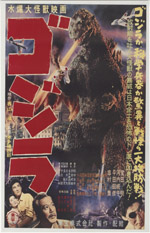 |
Poster for Gojira. Japan: Toho Ltd., 1954. [zoom] |
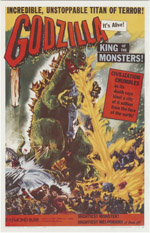 |
Poster for Godzilla, King of the Monsters!. Japan: Toho Ltd. and Jewell Enterprises, 1956. [zoom] These posters for the first Japanese Godzilla release and its early American remake highlight stark differences in the popular political consciousness of each country in the early 1950s. While the Japanese poster carefully depicts representatives of a humanity terrorized and fearful of an enormous, ray-emitting primitive monster, the American poster largely dehumanizes the destruction, instead exulting in the fiery power of a force that can “blast a city.” Notably, this is a city of six million, the number of victims made familiar by the Nazi holocaust. In fact, if Gojira can be characterized as a commentary on the indiscriminate use of weaponry against civilians, the American remake, using the device of Raymond Burr as a visiting reporter in Tokyo, allows for a voyeuristic presentation of the destruction of Japan, reminiscent of the war. |
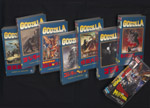 |
A Selection of Japanese Godzilla Films on Video. Japan: Toho Ltd., 1992-1998. [zoom] This selection of videos from the Olin Media Collection illustrates the variety of Godzilla films, in which the powerful monster transforms from enemy to ally of humankind, battling other threatening creatures before ultimately turning back to an enemy again. |
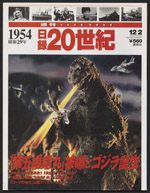 |
Daily Records of the Twentieth Century: Yearbook 1954. Tokyo: Iwanami, 1997. [zoom] The magnitude of Godzilla’s influence on postwar Japanese popular culture is suggested by this Japanese historical magazine, which singles out the birth of Godzilla as the signature event of the year 1954. |